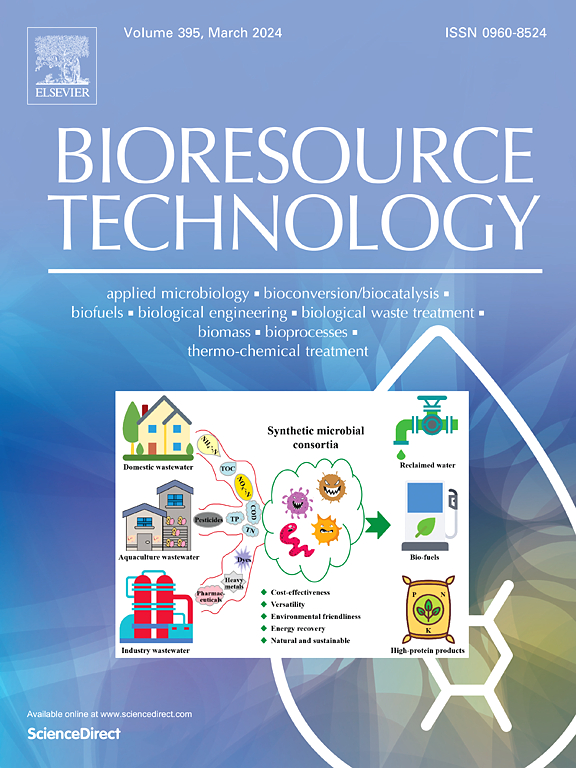将沼气中的二氧化碳与氢气一起转化为醋酸,在热醋酸摩尔氏菌滴床生物反应器或纯醋酸混合培养基中进行
IF 9
1区 环境科学与生态学
Q1 AGRICULTURAL ENGINEERING
引用次数: 0
摘要
与化学升级相比,将沼气中的二氧化碳(CO2)转化为附加值化学品(如乙酸)的气体发酵提供了一种可持续的解决方案。在这项研究中,我们比较了热乳酸Moorella(一种采用Wood-Ljungdahl途径的嗜热同质产乙菌)与富同质产乙活性的混合瘤胃培养物的性能。采用滴流床反应器(TBR)对两种培养物的CO2/H2转化效率、乙酸产量和沼气升级进行了评估,并向可再生天然气(RNG)中添加了H2。混合培养的氢(H2)转化率高达99.4%,二氧化碳(CO2)转化率高达95.1%,在工艺稳定性和体积生产率方面明显优于热乙酸m.s theracetica,乙酸产量达到22.3 g/L/d,生物质生产率为1.8 g/L/d。TBR产甲烷组分达到99.1%。这项工作强调了在气体发酵过程中纯培养和混合培养之间的权衡,强调了混合培养在波动过程条件下提高的生产力和卓越的稳定性,这对可扩展的工业应用具有重要意义。本文章由计算机程序翻译,如有差异,请以英文原文为准。
Converting CO2 from biogas with H2 into acetic acid in a trickle bed bioreactor with Moorella thermoacetica or a homoacetogenic mixed culture
Gaseous fermentation for converting carbon-dioxide (CO2 ) from biogas with H2 into value-added chemicals such as acetic acid offers a sustainable solution compared to chemical upgradation. In this study we compare the performance of Moorella thermoacetica , a thermophilic homoacetogen employing the Wood–Ljungdahl pathway, with a mixed rumen culture enriched for homoacetogenic activity. Both cultures were evaluated for CO2 /H2 conversion efficiency, acetic acid production, and upgrading of biogas and added H2 to renewable natural gas (RNG) using a trickle bed reactor (TBR). The mixed culture achieved high hydrogen (H2 ) conversion (99.4 %), and carbon-dioxide (CO2 ) conversion 95.1 %, significantly outperforming M. thermoacetica in process stability and volumetric productivity, with acetic acid yields reaching 22.3 g/L and biomass productivity of 1.8 g/L/day. Output methane composition of the TBR reached 99.1 %. This work highlights the trade-offs between pure and mixed cultures during gas fermentation, emphasizing the mixed culture’s enhanced productivity and superior stability under fluctuating process conditions of importance for a scalable industrial application.
求助全文
通过发布文献求助,成功后即可免费获取论文全文。
去求助
来源期刊

Bioresource Technology
工程技术-能源与燃料
CiteScore
20.80
自引率
19.30%
发文量
2013
审稿时长
12 days
期刊介绍:
Bioresource Technology publishes original articles, review articles, case studies, and short communications covering the fundamentals, applications, and management of bioresource technology. The journal seeks to advance and disseminate knowledge across various areas related to biomass, biological waste treatment, bioenergy, biotransformations, bioresource systems analysis, and associated conversion or production technologies.
Topics include:
• Biofuels: liquid and gaseous biofuels production, modeling and economics
• Bioprocesses and bioproducts: biocatalysis and fermentations
• Biomass and feedstocks utilization: bioconversion of agro-industrial residues
• Environmental protection: biological waste treatment
• Thermochemical conversion of biomass: combustion, pyrolysis, gasification, catalysis.
 求助内容:
求助内容: 应助结果提醒方式:
应助结果提醒方式:


